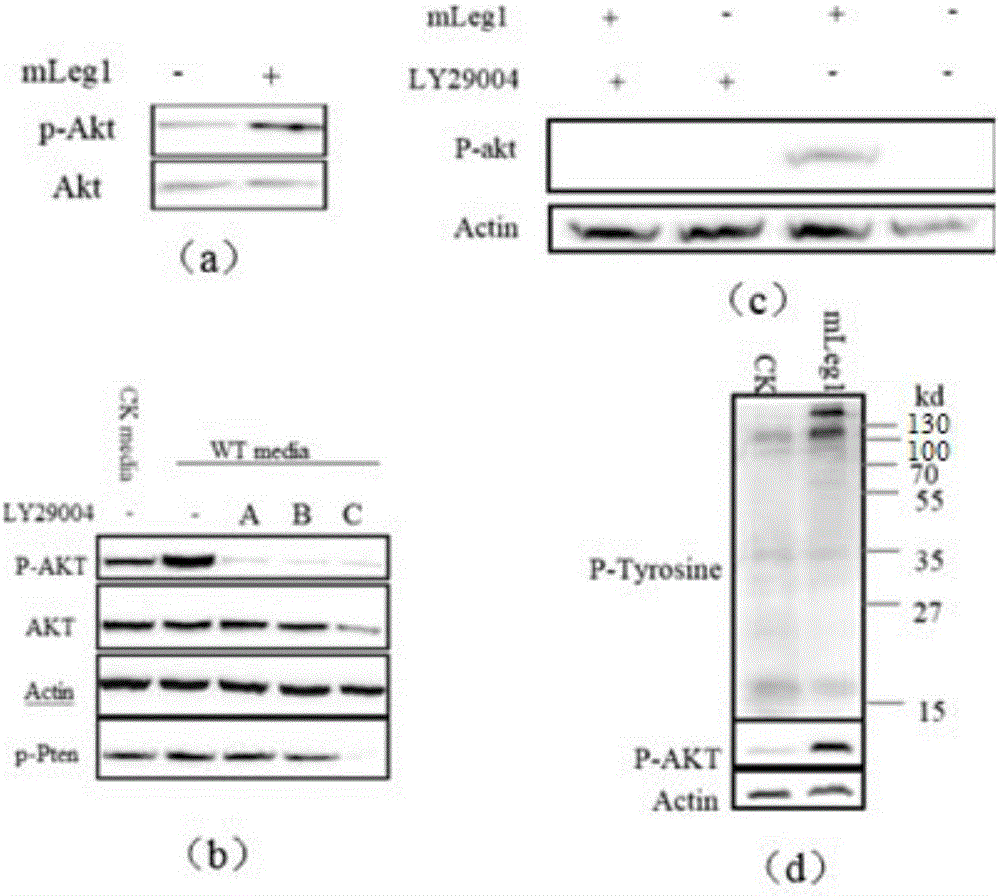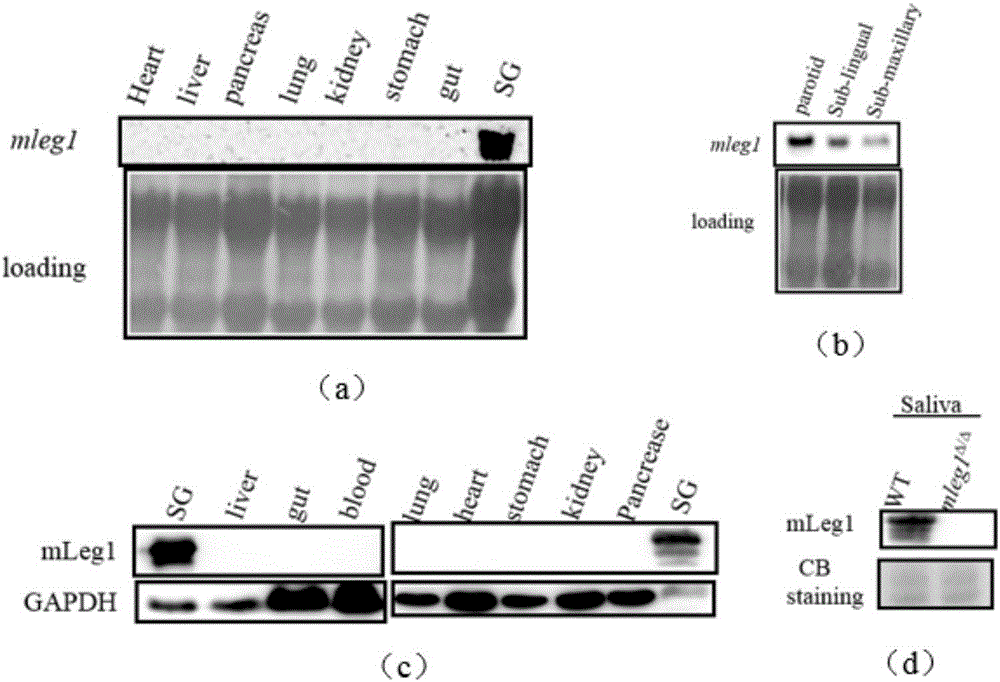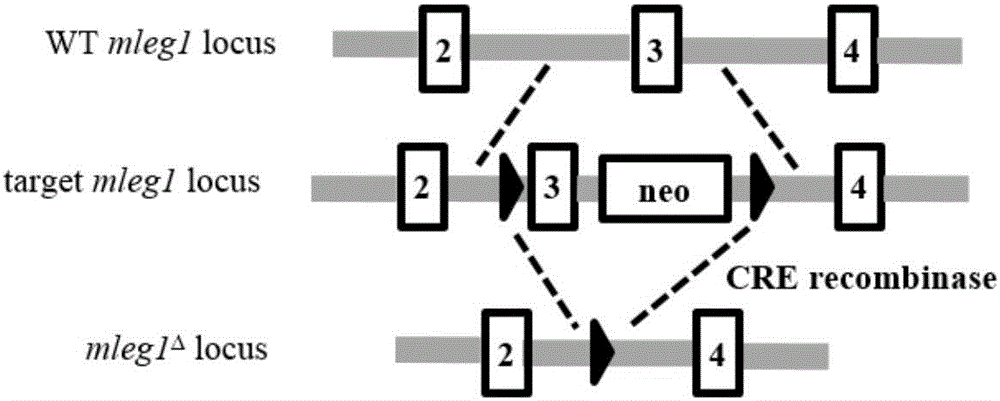Leg1 protein and application thereof in obesity-related diseases
A protein and obesity technology, applied to Leg1 protein and its application in obesity-related diseases, can solve problems such as few targets
- Summary
- Abstract
- Description
- Claims
- Application Information
AI Technical Summary
Problems solved by technology
Method used
Image
Examples
Embodiment 2
[0077] Since the homolog protein Leg1 of mLeg1 protein in zebrafish is a secreted protein, the above results have shown that mLeg1 gene is mainly expressed in salivary glands, but its mLeg1 protein may also be secreted and transported to other tissues to play a role. Therefore, the inventors of the present invention extracted the total protein from different tissues of mice, and detected the distribution of mLeg1 protein in different tissues by Western Blot.
[0078] Western Blot was used to detect the distribution of mLeg1 protein in different tissues. The experimental method is as follows.
[0079] 2.1 Protein extraction:
[0080] After the mice died suddenly, the target tissues (SG, liver, gut, blood, lung, heat, stomach, kindney, pancrease) were removed, placed in 1.5ml centrifuge tubes, and quickly frozen in liquid nitrogen to prevent degradation. When extracting protein, take out the sample, grind and pulverize by liquid nitrogen, collect the sample powder in a centrif...
Embodiment 3
[0088] Since the salivary gland is a secretory gland, its most important function is to secrete saliva, and mLeg1 is also a secretory protein. Therefore, the inventors of the present invention investigated whether mLeg1 is secreted into saliva.
[0089] The content of mLeg1 in saliva was detected by Western Blot. Specific steps are as follows.
[0090] 3.1 Saliva collection: 0.5 mg / kg of Pilocarpine (Sigma) was injected intraperitoneally into the mice, and a capillary was placed in the mouth of the mice to drain and collect the secreted saliva. Pilocarpine, a drug used to treat dry mouth, stimulates a flood of saliva. The saliva secreted by wild-type mice and mLeg1 systemic knockout mice (how to obtain them are described below) were collected respectively.
[0091] 3.2 Saliva treatment: the collected saliva was boiled at 100° C. for 5 minutes with 5x Laemmli buffer (10% SDS, 250 mM Tris-HCl, 0.1‰ Bromphenol blue, 500 mM DTT, 50% Glycerol) of 1 / 5 saliva volume.
[0092] 3.3...
Embodiment 4
[0095] Whole body knockout mice of mLeg1 gene (mLeg1 Δ / Δ ) of the acquisition
[0096] In order to obtain mleg whole-body knockout mice, the inventors of the present invention used the traditional Cre-loxP system to knock out the mLeg1 gene in mice. The system mainly relies on the Cre enzyme to recognize the loxP sequence and delete the sequences in the two loxP sequences in the same direction, so as to achieve the purpose of gene knockout. When the Cre enzyme is expressed at a specific time and space, mLeg1 can be knocked out at a specific time and space, thereby avoiding the research difficulties caused by embryonic lethality. Here, the inventors of the present invention inserted the loxP sequence into both sides of the third exon of mLeg1, and at the same time added a NEO gene between the third exon and the loxP sequence behind it for forward resistance screening . Through homologous recombination, embryo transfer and genetic screening, the inventors of the present inven...
PUM
 Login to View More
Login to View More Abstract
Description
Claims
Application Information
 Login to View More
Login to View More - R&D
- Intellectual Property
- Life Sciences
- Materials
- Tech Scout
- Unparalleled Data Quality
- Higher Quality Content
- 60% Fewer Hallucinations
Browse by: Latest US Patents, China's latest patents, Technical Efficacy Thesaurus, Application Domain, Technology Topic, Popular Technical Reports.
© 2025 PatSnap. All rights reserved.Legal|Privacy policy|Modern Slavery Act Transparency Statement|Sitemap|About US| Contact US: help@patsnap.com



